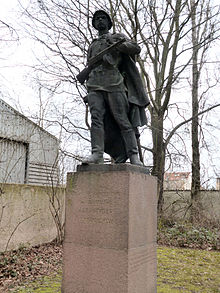Alexander Matvejewitsch Matrossow
Alexander Matrosov ( Russian Александр Матвеевич Матросов , scientific. Transliteration Aleksandr Matveevič Matrosov * 5. February 1924 in Ekaterinoslav , Ukrainian SSR ; † 27. February 1943 in Tschernuschki in Pskov Oblast ) was a symbol of the Red Army , and ( posthumously ) Held the Soviet Union .
Life
Soon after he was born, he lost his parents and grew up with his grandmother. After their death he was sent to the children's home and then the work colony for children in the city of Ufa took him in. In 1905, a Matrosov from his family led the uprising on the armored cruiser "Potjomkin " with Matyuschenko, who died in exile like his grandfather.
In school he began an apprenticeship as a locksmith . After the start of the war in 1941, armaments were manufactured in the labor colony. From March 15 to September 23, 1942 he worked as an assistant in a furniture factory. In 1942 he became a member of the Komsomol organization. He was drafted into the army and went to the Krasny Kholm Infantry School . In mid-January 1943 he was assigned to the front with half of the students.
The transport train drove to the Semzy station between Rzhev and Velikiye Luki , where it was unloaded. There he was accepted into the "Stalin Brigade" under the command of Derewjanko, which had been set up in October 1942 from volunteers in Siberia. This unit belonged to the Stalin Rifle Corps. She was subordinate to the Kalinin Front in October 1942 and intervened in the fighting in the Krasny Stan - Bely area in November . The brigade was now at rest and refreshed its strength with new men and equipment.
After this rest period, there was a 200-kilometer march to the front in the direction of Toropez and the towns of Strelzy, Demidowo, Kljukowo, Schilowo and Michai an der Lowat north of Velikiye Luki, where they should be concentrated. Then, should the space of urban settlement Loknya developed an attack, the railway line Loknja- Naswa pushed forward and this connection will be cut off. The second battalion of the brigade had the task of advancing to the village of Chernushki and conquering the enemy positions there in order to create an opening for the brigade to attack.
Behind Michai lay the Lomovaty Forest, which was to be crossed at dawn in order to then conquer the village of Chernushki. The opposing position consisted of earth bunkers and fire positions. Heavy weapons could not be used to attack because of the terrain. The enemy was the 113th Security Regiment of the German 285th Security Division .
On February 27, 1943, later dated back to February 23, 1943, the day the Red Army was founded, the attack of the 2nd Battalion against the position system, one of the best-secured firing positions of the enemy on the Kalinin Front, began. Around 20 bunkers were conquered in the course of the day. In the evening the enemy counterattacked, and the Matrossow unit was trapped. The enclosure was only blown up at dawn. During an attack on the main bunker of the opposing position, the battalion made no progress because the bunker dominated the entire battlefield. Then Matrossow crawled to the bunker and covered an arrow slit with his body, which resulted in him being fatally wounded. Then the bunker could be conquered and victory on this section of the front was assured.
The Presidium of the Supreme Soviet awarded Matrosov on June 19, 1943 the title of Hero of the Soviet Union. With the order No. 229 of September 8, 1943, the People's Commissar for Defense, Stalin , paid tribute to Matrosov's performance. a. called:
- “... The name of the 254th Guards Rifle Regiment of the 56th Guards Rifle Division is' 254. Guards Rifle Regiment Alexander Matrossow '. "
In the History Museum on Red Square in Moscow, a display case shows Matrosov with memorabilia. In 1975 a monument was erected in the city park in Halle (Saale) , which is now in the southern cemetery of the city on the Saale . The author of the monument is the sculptor Leonid Eidlin (1918–2001).
literature
- Central Council of Free German Youth (ed.): We learn from the Komsomol - the active builder of communism (= textbook for the circle "The social role of the free German youth in the struggle for peace, unity, democracy and socialism (constitution of the FDJ)" ). Verlag Junge Welt , Berlin, 1952, p. 30.
- Матросов , in: Советская Военная Энциклопедия , Vol. 8, Москва 1978, p. 195.
Web links
- Collection of various biographical encyclopedia entries about AM Matrossow (as of February 4, 2009)
- Monument to Alexander Matrosov on enlight.ru, Moskowsky Victory Park, Saint Petersburg
Individual evidence
- ↑ a b M. J. Broekmeyer, Stalin, the Russians, and Their War: 1941-1945 , Univ. of Wisconsin Press, 2004, ISBN 0-299-19594-5 , Google Print, p.206 (English)
- ↑ biography on warheroes.ru (Russian)
- ↑ Alexander Matrossow , in: Halle im Bild, accessed on September 4, 2018.
| personal data | |
|---|---|
| SURNAME | Matrossow, Alexander Matwejewitsch |
| ALTERNATIVE NAMES | Александр Матвеевич Матросов (Russian) |
| BRIEF DESCRIPTION | Soviet soldier, symbolic figure of the Red Army and Hero of the Soviet Union |
| DATE OF BIRTH | February 5, 1924 |
| PLACE OF BIRTH | Ekaterinoslav |
| DATE OF DEATH | February 27, 1943 |
| Place of death | Chernushki , Pskov Oblast |



